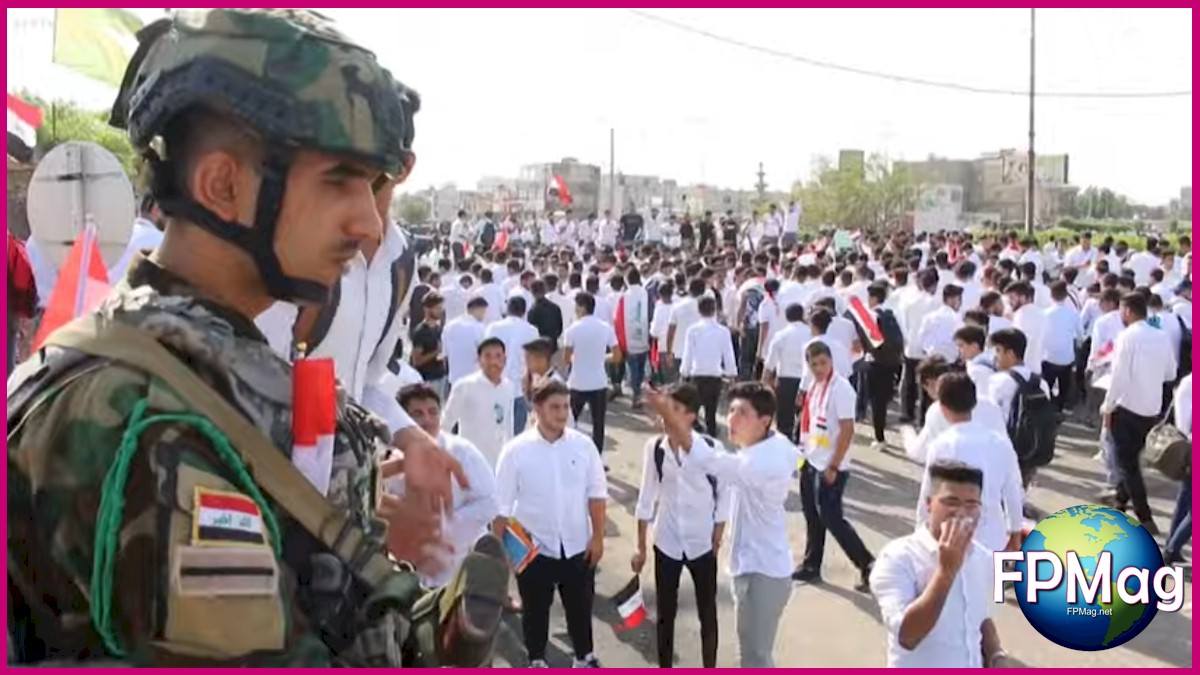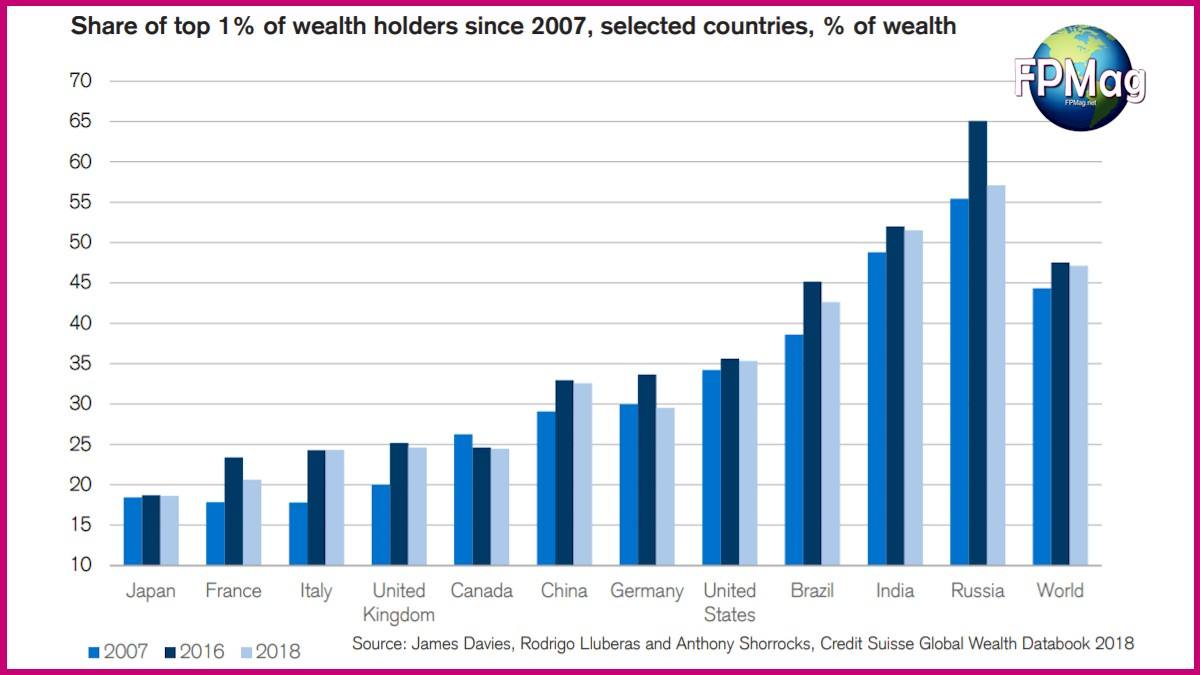The ruling class around the world has used for centuries the same basic corrupt techniques for mining populations’ earnings. Since 2007, however, that process went past the breaking point (see graph below). The global population is heading to the streets in mass protests and forecasters say that will continue.
Ruling class money controls the government which taxes the population. The ruling class then pockets the money through salaries in the private sector or through surrogacies and foreign bank accounts for public sector officials. This angers the population.
by Melissa Hemingway and Micheal John
 Rioting in Baghdad, AFTER ban on demonstrations.
Rioting in Baghdad, AFTER ban on demonstrations.
Photo Credit: Video Frame Capture from YouTube Video by Reuters.
Photo Art/Cropping/Enhancement: Rosa Yamamoto / Feminine-Perspective Magazine
What has changed, is the awareness. The digital revolution with its encyclopedic information storage, encrypted communication, and social media explosion is exposing the ruling class and also allowed dissenters to talk to each other. In this manner, protests and riots unite.
 Live fire by Iraqi security forces has been killing protestors. Photo Credit: Source Supplied
Live fire by Iraqi security forces has been killing protestors. Photo Credit: Source Supplied
Photo Art/Cropping/Enhancement: Rosa Yamamoto / Feminine-Perspective Magazine
“90 Percent of the global population is mined for its earnings by the top ten percent,” says an FPM.news correspondent in South America.
The last remaining human right of poor dissenters: Free Speech
Recent riots in Catalonia, Ecuador, Chile, Hong Kong, India, Iraq, Lebanon, Philippines and Russia are worth studying in the context of poverty and wealth distribution. What are people saying?
- The rich are getting richer and the poor are getting poorer.
- The ruling class is stealing money from the earnings of huge masses of population.
- Human rights are being whittled away.
- Failure to spend money on climate change mitigation and environmental protection.
- The ruling class is oppressing the working class and seeking its silence by denying human rights; creating diversionary crises; exerting control over the media; oppressing women and children; forced disappearance, arrest and murder of journalists; and by control of the internet.
The Global Facts imply that protestors are accurate in their complaints. But government corruption, unfairness and over-taxation may the compounded root.
The underlying issue is poverty. A prosperous society complains less?
It may be true that prosperous society complains less because in theory, a large functional middle-class is paramount to prosperity.
This theory comes from Confucianism by different terms.
But in more modern times, Hu Jintao, General Secretary of the Communist Party of China, between 2002 and 2012, preferred economic policies intended to realize a more equal distribution of wealth which led to a betterment of the middle class well-being. The result was a staggeringly successful drive from poverty to prosperity for a significant proportion of the world’s population: the Chinese people.
What are the protests saying?
The message in South America coming from millions of protestors according to Michele Francis, a nurse who has been working in Venezuela, Chile and Ecuador, “Those who can find a job, work until past mid-year to pay taxes; barely make ends meet; they say they get nothing back for their money; and it’s unfair,” she said.
The vast majority of protests in Baghdad and Hong Kong are young students. Young persons are a substantial portion of other demonstrations around the world.
Despite working hard, obtaining substantial academic standards and doing all the right things in accordance with the instructions of mentors, many students complain they have little hope for the future; no answer to the inequities of which their intelligent minds are cognisant; and no job prospects.
 Student demonstrators in Iraq last week. Photo Credit: Source Supplied Photo Art/Cropping/Enhancement: Rosa Yamamoto / Feminine-Perspective Magazine
Student demonstrators in Iraq last week. Photo Credit: Source Supplied Photo Art/Cropping/Enhancement: Rosa Yamamoto / Feminine-Perspective Magazine
In round numbers, according to numerous studies including those of Credit-Suisse (read global-wealth-report-2018) some fifty percent of the world’s wealth is controlled by less than one percent of the world’s population. For sake of argument, let’s remove the blurred lines and say this is the ruling class for argument’s sake.
Look at the countries where huge demonstrations have amassed.
If you look at the graphics chart that follows, you will see a startling trend line that suggests that the top earning 1% of populations of the world controls as much as 65% percent of their nations wealth.
 Share of top 1% of wealth holders since 2007, selected countries, % of wealth
Share of top 1% of wealth holders since 2007, selected countries, % of wealth
Source: James Davies, Rodrigo Lluberas and Anthony Shorrocks, Credit Suisse Global Wealth Databook 2018 Photo Art/Cropping/Enhancement: Rosa Yamamoto / Feminine-Perspective Magazine
Using other sources, / Feminine-Perspective Magazine has learned that in the Philippines, in the Asia Pacific economic region of this study, more than 85% of that nation’s wealth is in the hands of far less than 1% of the population. This is a radical increase since 2016.
Unofficial estimates for 2019 say a quarter of the Philippines population lives in desperate poverty. See the graph, ” Regional composition of global wealth distribution in 2018″ below. This is a plight of the Asia Pacific region.
The top ten percent of the global population owns eight-five percent of the world’s wealth.
What is unfair, in the eyes of protestors in South America says Michele Francis, “is that this group of people, seemingly pay no taxes. Basically the other ninety percent of the population is mined for its earnings by the top ten percent.”
“Those who can find a job, work until past mid-year to pay taxes, barely make ends meet; they say they get nothing back for their money; and it’s unfair,” says South American correspondent.
Credit-Suisse’s annual databank and report on global wealth for 2018 says, “while the bottom half of adults collectively owns less than 1% of total wealth, the richest decile (top 10% of adults) owns 85% of global wealth, and the top percentile alone accounts for almost half of all household wealth (47%). The shares of the top 1% and top 10% in world wealth fell significantly between 2000 and 2008: the share of the top percentile, for instance, declined from 47% to 43%. However, the trend reversed after the financial crisis. The share of the top 10% was little affected. But in 2016 the share of the top 1% rose back above the level we estimate for 2000. The trend in the share of the top 1% partly reflects the trend in the share of financial assets in the household portfolio, which fell during 2000-08 and then began to rise after the global financial crisis, raising the wealth of many of the richest countries, and of many of the richest people.”
 Regional Wealth Distribution 2018 – Feminine-Perspective Magazine Source: James Davies, Rodrigo Lluberas and Anthony Shorrocks, Credit Suisse Global Wealth Databook 2018
Regional Wealth Distribution 2018 – Feminine-Perspective Magazine Source: James Davies, Rodrigo Lluberas and Anthony Shorrocks, Credit Suisse Global Wealth Databook 2018
Photo Art/Cropping/Enhancement: Rosa Yamamoto / Feminine-Perspective Magazine
Recruiters in Iraq are Scoring good numbers for ISIS
The worst possible security scenario for disenchanted masses in Iraq is joining a Salafi-jihadist organisation like ISIS.
The fundamentalists of ISIS have roots in the Sunni Ba’athist Party of Saddam Hussein. They live in the region of Iraq where the Tigris river meets the Euphrates.
Part of their disenchantment motivation for recruitment was the 2003 destruction of the Saddam Hussein’s Sunni Muslim Ba’athist regime; and the big insult is that it was replaced by the Shia regime of the south of Iraq and Iran.
“The conflict between Sunni Muslims and the Shiite Muslims of the Middle East has been the root of hostilities for some 14 centuries,” says Katie Alsop who has a masters degree in Middle East affairs and is a director of The RINJ Foundation.
“The resentment of male dissenters who have become rioters in Iraq, and even those who are non-participant but sympathetic, is already high,” says FPM.news correspondent “Jessica” who from Mosul talked to recruiters known to FPM.news in Kirkuk and in Baghdad and confirmed that they have been instructed to become actively recruiting using an anti_Shia/anti-government narrative.